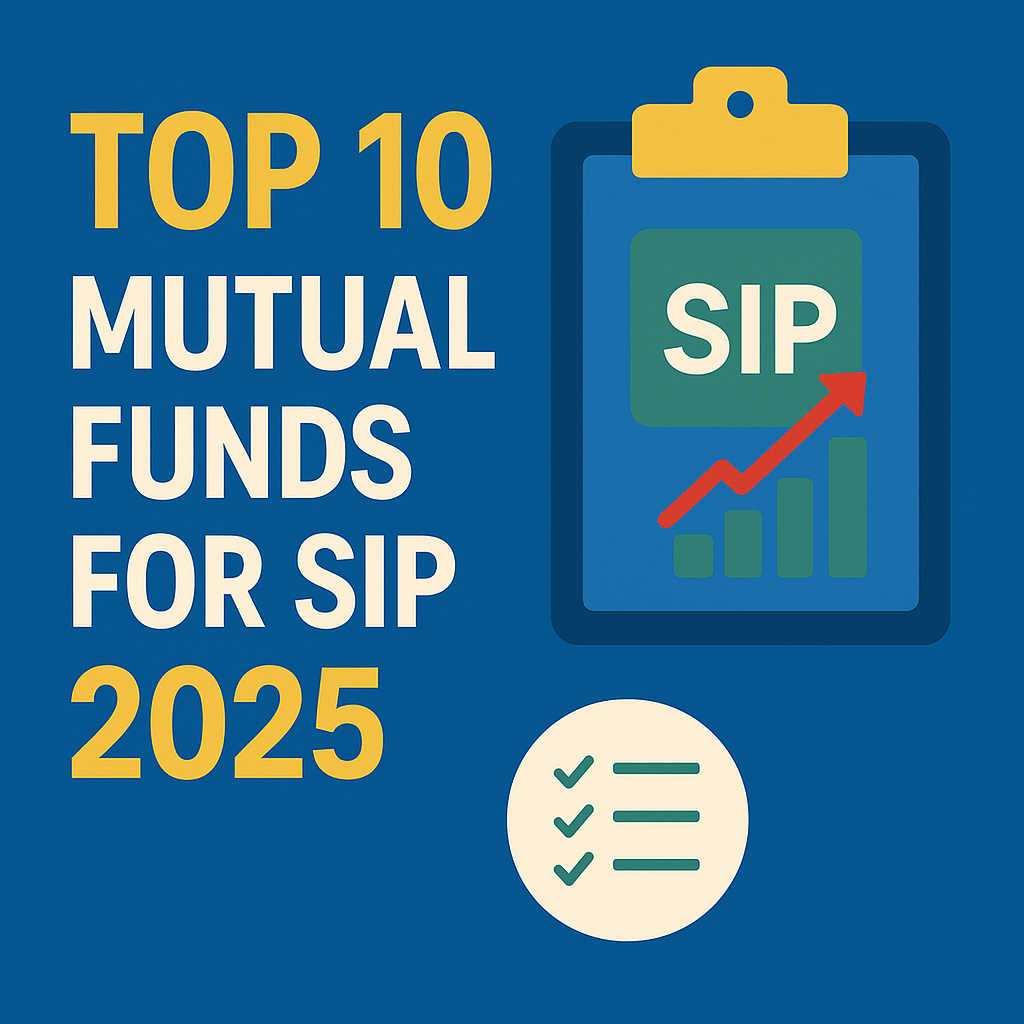Start small, stay steady. This roundup explains why a sip automates disciplined investing and how regular contributions help build wealth in Indian markets. You’ll get a concise 2025 outlook across equity, debt, and hybrid categories plus clear criteria we used to pick funds: expense ratio, past returns, AUM quality, manager track record, and risk profile.

Expect practical guidance. We show how rupee cost averaging and compounding work, and how to begin with ₹500 or ₹1,000. The list includes Large Cap, Mid Cap, Small Cap, ELSS and Hybrid options with the right horizon for each investor type. You’ll also find app suggestions like Groww and Zerodha Coin and a built-in tool to forecast goal progress.
Key Takeaways
- Small, regular contributions make long-term growth achievable through disciplined investing.
- Selection focused on expense, consistency of returns, AUM strength, and manager track record.
- Rupee cost averaging plus compounding can boost wealth with step-up or pause flexibility.
- Starter amounts such as ₹500/₹1,000 are viable; match horizon to risk tolerance (3, 5, 10+ years).
- We include category picks, tax-saving ELSS options, and apps to start quickly.
- Each fund is shown with NAV, AUM and expense data to aid confident decision making.
Why SIPs Are India’s Favorite Way to Invest in Mutual Funds
SIPs let you invest a fixed amount at regular intervals so you buy more units when prices fall and fewer when they rise.
A systematic investment plan automates debits from your bank to an AMC on a chosen date. Each installment purchases units at that day’s NAV, making regular investments simple and emotion-free.
Rupee cost averaging smooths the impact of market volatility and lowers average purchase cost over time. Compounding then helps that accumulated corpus grow as returns get reinvested.
- Start small (₹500 or ₹1,000) and build habit without a lump sum.
- Pause or step-up contributions to match income and life changes.
- Choose risk-appropriate funds to align horizon and volatility tolerance.
“Automation and discipline often beat timing the market when building long-term wealth.”
| Feature | What it does | Why it matters |
|---|---|---|
| Auto-debit | Transfers fixed amount to AMC | Removes timing bias |
| Unit accumulation | Buys units at daily NAV | Enables rupee cost averaging |
| Flexibility | Pause or increase contributions | Fits income growth and goals |
2025 Outlook for Mutual Funds in India
With structural growth intact, investors should blend equity exposure with defensive allocations to manage volatility. A clear core-satellite approach helps capture market upside while limiting downside.

Equity, Debt, and Hybrid mix: positioning for growth with risk control
Use a core allocation to large cap and flexi-cap strategies for steady earnings. Add satellite cap funds across mid and small segments for higher growth potential.
High-quality debt and dynamic hybrid funds act as ballast. They reduce risk and simplify rebalancing during market swings.
Tax planning in 2025: leveraging ELSS and efficient categories
For Section 80C benefits, ELSS choices offer equity exposure plus a three-year lock-in that enforces discipline. Expense discipline matters—lower costs in mutual fund schemes help compound net returns over the long term.
“A disciplined mix and cost-aware selection often beat timing moves over the long term.”
| Allocation | Role | Horizon | Why it matters |
|---|---|---|---|
| Large cap core | Anchor volatility | 5-10+ years | Steadier earnings and depth |
| Mid/small cap satellite | Growth engine | 7-10+ years | Higher return potential with patience |
| Hybrid/debt | Risk buffer | 3-7 years | Smoother journeys and simpler rebalancing |
| ELSS | Tax saving + equity | 3+ years (lock-in) | Section 80C optimization and discipline |
How We Picked the Top SIP Funds for 2025
To reach our shortlist, we used a clear, repeatable screening process that blends numbers with judgment. We prioritized low ongoing cost, consistent performance across cycles, and managers who run a documented process.
What we measured: expense ratio, past consistency, and AUM quality
Expense discipline matters because lower fees leave more to compound. We favored schemes with competitive expense ratios and steady net expense trends.
Rolling consistency beat single-year spikes. We scored long-term returns and volatility across market regimes.
Fund manager track record and investment process
Managers must show tenure and a repeatable process. We looked for documented portfolio construction, risk controls, and stewardship practices.
Risk profile and ideal investment horizon (3, 5, 10+ years)
Each fund was mapped to an investor type and horizon. That helps match volatility tolerance to realistic goals.
| Fund | Expense (%) | AUM (₹ Cr) | Suggested horizon |
|---|---|---|---|
| Kotak Equity Opportunities | 0.47 | 25,293 | 5-10+ years |
| DSP Flexi Cap | 0.67 | 12,139 | 5-10+ years |
| Edelweiss Large & Mid Cap | 0.45 | 3,655 | 7-10+ years |
| Mirae Asset Large & Midcap | 0.59 | 40,205 | 5-10+ years |
| Quant Large & Mid Cap | 0.61 | 3,707 | 7-10+ years |
- Liquidity & AUM quality: enough scale without loss of flexibility.
- Rolling returns: used to dampen timing luck for periodic investments.
- Category fit: large and flexi-cap funds anchor cores; mid/small caps act as growth satellites.
“A disciplined, data‑driven sieve plus qualitative checks gives SIP investors a practical shortlist that works across market cycles.”
Key Benefits of SIPs for Long-Term Wealth Creation
Small, steady contributions turn market swings into an advantage. By buying at regular intervals, investors accumulate more units when prices fall and fewer when they rise. That process builds a base that grows over time.

Rupee cost averaging explained with a real unit-cost example
Here is a simple six-month example using a ₹10,000 monthly contribution with NAVs of ₹50, ₹52, ₹65, ₹51, ₹48, ₹45.
The purchases: 200, 192.30, 153.84, 196.07, 208.33, 222.22 units. Total units = 1,172.76 for an investment amount of ₹60,000. The average rupee cost per unit = ₹51.16.
The power of compounding with regular investments
Each unit you hold participates in future growth. As your unit count rises, even modest market appreciation increases corpus faster. This is the power compounding effect.
Staying invested across cycles helps compounding beat sporadic timing attempts. Over the long term, consistent regular investments tend to smooth returns.
Flexibility and affordability: start with ₹500/₹1,000, pause or step-up
You do not need a lump sum to begin. A SIP can start at ₹500 or ₹1,000 and still add meaningful units over years in a mutual fund or other fund types.
Options to pause or step-up help match changing income. That flexibility reduces stress from market volatility and keeps discipline intact.
| Benefit | How it helps | Practical note |
|---|---|---|
| Cost averaging | Reduces average entry price | Example average rupee cost ₹51.16 over six months |
| Unit accumulation | More units bought when NAV is lower | Builds a larger base for compounding |
| Affordability & flexibility | Start small, pause or increase contributions | Fits budgets and income growth |
“Consistency and process typically outperform attempts to time the market.”
SIP Calculator: Forecast Your Returns in 2025
A simple online estimator shows the impact of monthly contributions, tenure, and assumed returns on your corpus. This makes it easier to set realistic targets and choose an investment plan.
How the tool estimates future value, CAGR, and goals
Enter your monthly amount, tenure, and an expected annual return. The tool compounds each instalment and provides a projected corpus at maturity.
It also calculates the implied CAGR and breaks results into periodic snapshots. You can see estimated units accumulated, which helps you visualise how the regular debit grows.
Where to start SIPs quickly
Try platforms like Groww, Zerodha Coin, ET Money, and Kuvera to begin sip investments. They let you test “what-if” scenarios—step-ups, pauses, or delayed starts—so you can adjust the monthly amount to meet goals.
| Use case | What to input | Outcome |
|---|---|---|
| Goal planning | Monthly amount, tenure, expected return | Projected corpus and implied CAGR |
| What‑if testing | Step-up %, pause months | Impact on target probability |
| Monitoring | Actual returns vs assumptions | Adjust contribution or horizon |
Start small—₹500 or ₹1,000 is a practical fixed amount. Revisit inputs after major life changes and track actual returns against projections to keep the plan realistic.
best mutual funds for SIP 2025 SIP calculator best SIP plans in India SIP inve
A quick simulation helps you compare likely outcomes across curated schemes and timelines. Use the sip calculator to estimate corpus growth, test step-ups, and stress-test shortlists against different return assumptions.

Focus on durable factors when comparing each option. Look beyond trailing returns and check expense ratios, AUM quality, manager approach, and volatility controls.
Keep monthly contributions flexible so you can step-up as income rises. Match tenure and risk to your goal timeline — shorter goals need more conservative allocations.
- Compare rolling returns and downside capture, not just one‑year spikes.
- Decide whether a fund plays a core or satellite role to avoid overlap.
- Shortlist two to three schemes per category and revisit them annually.
“Let data guide your choices, but align every pick with your tolerance and goals.”
| Action | Why it matters | Result |
|---|---|---|
| Run scenario in calculator | Tests tenure, monthly amount, and returns | Projected corpus and implied CAGR |
| Check expense & AUM | Lower costs and scale support compounding | Higher net returns over time |
| Shortlist & diversify | Reduces execution and strategy risk | Smoother journey toward goals |
Top 10 Best Mutual Funds for SIP in 2025 — Expert Picks by Category
We’ve grouped ten select schemes by category to make diversification simple and actionable for monthly investing.
Snapshot: anchor your portfolio with large and flexi cap choices, add mid and small cap satellites, include an ELSS for tax planning, and use a dynamic hybrid to moderate risk.
Large & Flexi Cap Candidates
Kotak Equity Opportunities — expense 0.47%; AUM ₹25,293 Cr; SIP min ₹500. Low expense and balanced style make it a core anchor.
DSP Flexi Cap Direct — expense 0.67%; AUM ₹12,139 Cr; SIP min ₹500. Broad market access and a process-driven approach.
Mirae Asset Large & Midcap — expense 0.59%; AUM ₹40,205 Cr; SIP min ₹1,000. Growth-oriented core with scale.
Large & Mid Blend
Edelweiss Large & Mid Cap Direct — expense 0.45%; AUM ₹3,655 Cr; SIP min ₹500. Cost-efficient bridge between caps.
Quant Large & Mid Cap — expense 0.61%; AUM ₹3,707 Cr; SIP min ₹1,000. Dynamic style; watch volatility while pursuing alpha.
Mid and Small Cap Satellites
Motilal Oswal Midcap — category AUM ₹33,609 Cr; focused mid-cap exposure suitable for a 7–10+ year horizon.
Quant Small Cap — category AUM ₹29,463 Cr; aggressive alpha-seeking; expect higher drawdowns but potential high returns.
Nippon India Small Cap — category AUM ₹65,922 Cr; broad small-cap footprint; disciplined monthly investing helps manage swings.
ELSS & Hybrid Picks
ELSS options give Section 80C benefit with a three-year lock-in; choose funds with proven process and reasonable expense.
Dynamic hybrid or balanced advantage schemes flex equity and debt to reduce risk while pursuing steady returns over the long term.
“Diversify across core anchors and growth satellites, use expense and manager process as tiebreakers, and rebalance annually.”
| Category | Representative pick | Expense | AUM (₹ Cr) |
|---|---|---|---|
| Large & Flexi | Kotak Equity Opportunities | 0.47% | 25,293 |
| Large & Mid | Edelweiss Large & Mid Cap | 0.45% | 3,655 |
| Small Cap | Nippon India Small Cap | (varies) | 65,922 |
How to use this list: size mid/small allocations to your comfort and horizon. Use large and flexi cap funds as anchors. Apply expense, consistency, and manager process as tie-breakers when choices look similar.
Large Cap Funds for Stable Growth (Beginner-Friendly)
If you want a smoother ride while you learn monthly investing, start with high-quality large cap selections. These choices lower volatility and help you build habit with steady equity exposure.

Kotak Equity Opportunities
Expense: 0.47% • AUM: ₹25,293 Cr • SIP min: ₹500.
Low expense and scale support better net outcomes. Suitable as a core fund scheme with a 5–10+ year horizon.
DSP Flexi Cap Direct
Expense: 0.67% • AUM: ₹12,139 Cr • SIP min: ₹500.
Diversified across caps, it smooths category swings and fits new sip investors seeking balanced exposure.
Mirae Asset Large & Midcap
Expense: 0.59% • AUM: ₹40,205 Cr • SIP min: ₹1,000.
Growth tilt with scale; use as a core allocation over a 7–10+ year horizon if you accept slightly higher risk.
- Focus on rolling returns and downside capture rather than single-year numbers.
- Keep the monthly amount realistic and let units accumulate through cycles.
- Revisit expense trends and peer performance annually to ensure your mutual fund scheme stays competitive.
“Consistency and low cost compound into better long-term outcomes.”
| Scheme | Expense | AUM (₹ Cr) | Suggested horizon |
|---|---|---|---|
| Kotak Equity Opportunities | 0.47% | 25,293 | 5–10+ years |
| DSP Flexi Cap Direct | 0.67% | 12,139 | 5–10 years |
| Mirae Asset Large & Midcap | 0.59% | 40,205 | 7–10+ years |
Mid Cap Funds for Higher Growth Potential (Moderate Risk)
Mid-cap allocations can act as the growth engine of a portfolio when paired with a steady large-cap core. These schemes aim to capture earnings expansion and market re-rating, but they carry wider swings than large-cap options.
Motilal Oswal Midcap Fund
Why consider it: concentrated mid-cap exposure targets growth drivers across sectors.
AUM: ₹33,609 Cr • SIP min: ₹500–₹1,000 • Horizon: 7–10+ years.
Risk note: higher volatility; treat as a satellite allocation and avoid oversized weightings versus your core.
Edelweiss Large & Mid Cap Fund
Why consider it: a blended approach that balances stability and upside potential.
Expense: 0.45% • AUM: ₹3,655 Cr • Horizon: 7–10+ years.
Risk note: smoother ride than pure mid-cap schemes; useful when you want growth with some defensive tilt.
Quant Large & Mid Cap Fund
Why consider it: a dynamic, aggressive style aimed at alpha generation across mid and large caps.
Expense: 0.61% • AUM: ₹3,707 Cr • Horizon: 7–10+ years.
Risk note: expect larger drawdowns; allocate modestly and monitor style drift if you are newer to sips.
- Size mid-cap allocations prudently relative to your large-cap core to avoid over‑cycling portfolio risk.
- SIPs smooth entry across market cycles; rolling return dispersion can be wide in this category.
- Watch expense and consistency — small fee differences matter over long horizons.
“Use mid-cap as a growth satellite; patience and a clear monthly amount help capture earnings re-rating over cycles.”
Small Cap Funds for Aggressive Investors (High Risk, High Reward)
Small-cap allocations can swing widely, but they also offer outsized gains when cycles turn. These options suit investors who accept deeper drawdowns and a 10+ year horizon to capture full recovery and growth.

Quant Small Cap Fund
Why consider it: an aggressive approach that seeks alpha in smaller companies. AUM ₹29,463 Cr signals capacity and market reach.
Note: expect higher volatility and episodic underperformance; use disciplined sip contributions to average into weakness.
Nippon India Small Cap Fund
Why consider it: one of the largest small-cap pools with AUM ₹65,922 Cr, offering broad coverage across the segment.
Note: large AUM helps liquidity, but market volatility still produces deep drawdowns—plan the monthly amount and stick to sips to buy more units in corrections.
- Allocate small caps as a satellite and anchor portfolio with large or flexi-cap choices.
- Review downside capture and standard deviation so you are prepared for swings.
- Reassess annually to confirm process and liquidity management stay intact.
| Scheme | AUM (₹ Cr) | Suggested horizon | Key note |
|---|---|---|---|
| Quant Small Cap | 29,463 | 10+ years | Aggressive alpha focus; high risk, use SIP discipline |
| Nippon India Small Cap | 65,922 | 10+ years | Broad footprint and liquidity; SIPs mitigate timing risk |
“Use SIP discipline to stay the course and avoid reactive moves during turbulence.”
Tax-Saving ELSS and Hybrid Funds for Balanced Portfolios
Combine tax-saving equity options with dynamic hybrid schemes to balance growth and stability.
ELSS — tax-efficient equity with a three-year lock-in
Equity-linked savings schemes (ELSS) qualify for Section 80C deductions and carry a mandatory three-year lock-in. That lock-in encourages a holding period long enough for equity to work in your favor.
Pick ELSS mutual fund schemes with a consistent process and competitive expense ratios. Align your ELSS allocation with overall equity exposure so you do not overweight one style or sector.
“Using SIPs across the year rather than last-minute lumps helps average entry points and spreads the cash-flow impact.”
Hybrid / Balanced Advantage — smoother rides over 5+ years
Hybrid or balanced advantage fund schemes shift between equity and debt to cushion drawdowns while staying in the market during uptrends.
These options suit a five‑plus year horizon where moderated volatility helps investors stay invested. Use SIPs to build exposure gradually while the manager rebalances asset mix.
- Pair an ELSS slice for tax benefit with a hybrid core for stability.
- Keep the monthly amount manageable and review allocation yearly.
- Set realistic return expectations: hybrids aim to reduce risk, not chase peak gains.
Conclusion
, A simple discipline—regular contributions, periodic review, and low cost—turns market swings into progress.
Choose a core of large/flexi‑cap schemes such as Kotak Equity Opportunities (expense 0.47%, AUM ₹25,293 Cr), DSP Flexi Cap (0.67%, ₹12,139 Cr) or Mirae Asset Large & Midcap (0.59%, ₹40,205 Cr). Add satellites like Edelweiss Large & Mid Cap (0.45%, ₹3,655 Cr), Motilal Oswal Midcap (AUM ₹33,609 Cr) and selective small cap exposure via Quant (AUM ₹29,463 Cr) or Nippon India Small Cap (AUM ₹65,922 Cr).
Which path is right? The safest sip choice is a large‑cap or balanced advantage core that moderates drawdowns. Small and mid caps can deliver higher long‑run returns but carry greater risk. Start with a practical monthly amount—₹500 or ₹1,000—and use a sip calculator to align the totals with your goals.
FAQ
What is a systematic investment plan and how does it work?
A systematic investment plan (SIP) lets you invest a fixed amount at regular intervals into a mutual fund. Each instalment buys fund units at the prevailing net asset value (NAV). Over time, rupee cost averaging helps lower the average purchase price, while power compounding can grow wealth when returns are reinvested.
How much should I start with and can I change the amount later?
Many platforms allow starting with as little as ₹500 or ₹1,000 per month. You can increase the amount using a step-up facility, pause contributions, or stop them. Changing the SIP amount is usually simple via your fund house or the investment platform like Groww, Zerodha Coin, ET Money, or Kuvera.
What time horizon should I choose for different fund categories?
Time horizon depends on risk and category. Large-cap funds suit 5–10+ years, mid-cap funds typically 7–10+ years, and small-cap funds need a 10+ year horizon due to higher volatility. ELSS has a mandatory 3-year lock-in and hybrid funds work well over 5+ years for smoother returns.
How do fees and expense ratio affect my returns?
Expense ratio reduces the net returns you receive because it is deducted from the fund’s assets. Lower expense ratios can boost long-term returns, especially in passive or large-cap strategies. Compare expense ratios alongside past consistency and AUM quality when choosing a scheme.
What is rupee cost averaging and why does it matter?
Rupee cost averaging means you buy more units when NAVs are low and fewer when NAVs are high, which can lower your average purchase price over time. This reduces timing risk and suits regular investors facing market volatility.
How do I use a SIP calculator to forecast returns?
A SIP calculator requires your monthly contribution, investment period, and assumed annual return rate (CAGR). It projects the future corpus, total invested amount, and estimated returns. Use realistic return assumptions and run multiple scenarios to set achievable goals.
Are tax-saving ELSS funds a good option for 80C benefits?
ELSS funds offer Section 80C tax benefits and have a 3-year lock-in. They can be a good choice if you want equity exposure plus tax savings. Evaluate fund performance and expense ratio before investing, since short lock-ins can still expose you to market swings.
How should I balance risk across equity, debt, and hybrid funds?
Balance based on financial goals, risk tolerance, and time horizon. Younger investors seeking growth may overweight equity (large, mid, small cap). Conservative investors can add debt or hybrid funds to reduce volatility. Rebalance periodically to maintain your target allocation.
What role does the fund manager track record play in selection?
A consistent, experienced fund manager with a clear investment process is important. Look at long-term consistency across market cycles, risk-adjusted returns, and turnover. Track record matters particularly for active and mid-/small-cap strategies.
Can I invest in multiple SIPs across categories?
Yes. Diversifying across large-cap, mid-cap, small-cap, ELSS, and hybrid funds can spread risk and capture different growth drivers. Design allocations to match your risk profile and re-evaluate annually to ensure alignment with goals.
How do market downturns affect SIPs and should I stop investing?
Market downturns reduce NAVs in the short term, which can be unsettling, but SIPs benefit from buying at lower NAVs during dips. Stopping SIPs often locks in losses and misses recovery. Maintain discipline, review your asset mix, and only pause if your goals or risk tolerance change.
What is the difference between lump-sum and SIP investing?
Lump-sum involves investing a large amount at once, which can yield strong returns if timed well but carries timing risk. SIP spreads investments over time, reducing timing risk through rupee cost averaging and making it easier to harness power compounding with smaller, regular contributions.
Which platforms can I use to start and manage SIPs?
Popular Indian platforms include Groww, Zerodha Coin, ET Money, and Kuvera. Each offers SIP setup, calculators, portfolio tracking, and research. Compare fees, ease of use, and available fund lists before choosing a platform.
How do I assess a fund’s risk-adjusted performance?
Use metrics like alpha, beta, Sharpe ratio, and standard deviation along with absolute returns. Risk-adjusted measures show how much return a fund generated per unit of risk. Combine these metrics with qualitative checks on process and AUM quality.
When should I consider switching or exiting a scheme?
Consider switching if the fund consistently underperforms its benchmark and peers, the investment mandate or fund management changes negatively, or your financial goals and risk profile change. Assess exit loads and tax implications before making a move.






![AI Tools for Social Media Creators: Instagram, TikTok & LinkedIn [2025]](https://niftynautanki.com/wp-content/uploads/2025/09/AI-009-120x86.png)


Comments 1